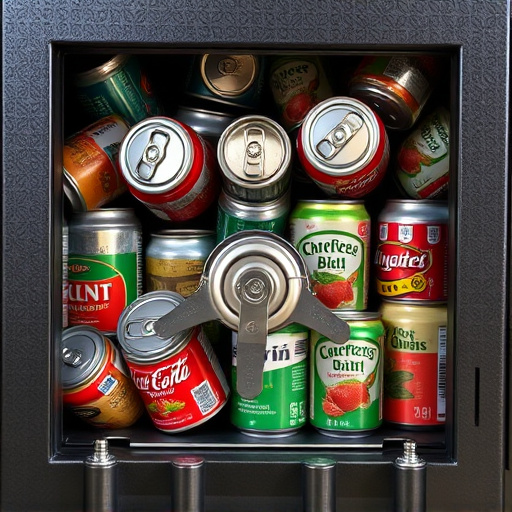In a space-challenged world, everyday items like empty peanut butter jars are being creatively repurposed as hidden storage solutions. These innovative 'Empty Peanut Butter Jar Safes' offer discreet and secure spaces for valuable items, blending seamlessly into household environments. By modifying the jar with cavities or special locks, users can safeguard small essentials while maintaining aesthetics. However, the use of such hidden compartments carries ethical and legal considerations, balancing personal security with potential privacy invasions and illegal activities.
Discover the surprising world of hidden compartments in common household items. From an innocent-looking empty peanut butter jar serving as a safe space, to creative hiding spots for discreet storage, this article unlocks the secrets tucked away in your everyday belongings. Learn about innovative security measures to create your own secret compartments and explore the ethical considerations and legal implications of concealed storage.
- Unlocking the Secrets: Hidden Compartments in Everyday Items
- The Unexpected: Empty Peanut Butter Jar as a Safe Space
- Creative Hiding Spots for Discreet Storage
- Security Measures: Making Your Own Secret Compartments
- Ethical Considerations and Legal Implications of Concealed Storage
Unlocking the Secrets: Hidden Compartments in Everyday Items
Unlocking the Secrets: Hidden Compartments in Everyday Items
In today’s world, where space is often at a premium, it’s no surprise that creators have found innovative ways to maximize storage. Beyond the obvious, everyday items like empty peanut butter jars can serve as more than just containers; they can be transformed into concealed safes for keeping valuable items out of sight. By understanding the design and material composition of these household objects, one can unlock their hidden potential. A simple jar, when modified with specific techniques, can provide a secure stash for small trinkets, cash, or even important documents.
The allure lies not only in the element of surprise but also in the accessibility. These hidden compartments offer an efficient solution for discreet storage without compromising aesthetics. Whether it’s tucked away in a bookshelf or seamlessly integrated into a kitchen cabinet, these everyday items can become secret sanctuaries, safeguarding personal possessions from prying eyes and unexpected situations.
The Unexpected: Empty Peanut Butter Jar as a Safe Space
In the realm of hidden compartments, one would be hard-pressed to find a more unexpected location than an empty peanut butter jar. This seemingly mundane household item can transform into a clever and discreet safe space for those with creative minds. With a bit of modification, the jar’s interior can accommodate small treasures or sensitive items, offering a secure hiding place right under your nose.
Imagine stowing away a flash drive containing crucial documents within this harmless-looking container, or keeping a stash of emergency cash hidden from prying eyes. The empty peanut butter jar, with its familiar shape and easy accessibility, provides an innovative solution for discreet storage. Its size makes it versatile, suitable for hiding in plain sight without raising suspicion.
Creative Hiding Spots for Discreet Storage
In the quest for discreet storage, creative hiding spots are often more accessible than one might think. An empty peanut butter jar, for instance, can be a clever and safe option. With its familiar shape and size, it blends seamlessly into a kitchen cabinet or pantry, making it an excellent choice for stashing small items like spare keys, cash, or even important documents. The jar’s sealed nature ensures the contents remain hidden and secure.
This simple solution is just one of many everyday household items that can double as secretive compartments. From vintage-style medicine bottles to hollowed-out books, these seemingly innocuous objects offer a unique way to keep valuables out of sight. By utilizing such creative hiding spots, individuals can maintain a sense of security and privacy while ensuring their possessions are readily accessible when needed.
Security Measures: Making Your Own Secret Compartments
Creating your own secret compartment within common household items, like an empty peanut butter jar, can be an intriguing way to enhance security and privacy. This DIY approach allows for tailored solutions that fit specific needs, offering a unique advantage over store-bought options. An Empty Peanut Butter Jar Safe, for instance, can be transformed into a discreet storage space for valuable items or sensitive documents.
By utilizing simple tools and materials, you can drill hidden cavities into the jar’s walls or modify its lid to create a compartment. The key is to ensure structural integrity while maintaining secrecy. Consider using advanced techniques like laser cutting for precise results or employing magnetic locks for added security, especially if the jar is meant to hold electronics. This personalized method guarantees that only authorized individuals can access your hidden stash, making it an excellent option for those seeking creative and effective hiding spots.
Ethical Considerations and Legal Implications of Concealed Storage
While the idea of a hidden compartment in everyday items like an empty peanut butter jar safe might seem intriguing, it raises important ethical and legal questions. The concept of concealed storage blurs the lines between privacy and potential illicit use. On one hand, it can empower individuals to securely store valuable items or sensitive documents out of sight, enhancing their safety. However, this practice also opens doors for misuse—from concealing illegal substances to hiding evidence, which has severe legal ramifications.
In many jurisdictions, the law treats hidden compartments as potential violations of privacy and evidence handling regulations. The ethical dilemma lies in balancing personal security with public safety and the integrity of legal proceedings. As such, it’s crucial to consider the context and purpose of using such methods, ensuring they do not facilitate criminal activities or hinder lawful investigations.
In conclusion, hidden compartments in everyday items like the seemingly innocuous empty peanut butter jar offer both creative storage solutions and intriguing security measures. While these clandestine spaces can enhance discretion and privacy, it’s crucial to navigate their use responsibly, considering ethical boundaries and legal implications. Understanding the art of concealing secrets within ordinary objects encourages a thoughtful approach to personal security and discretely storing valuable items.
